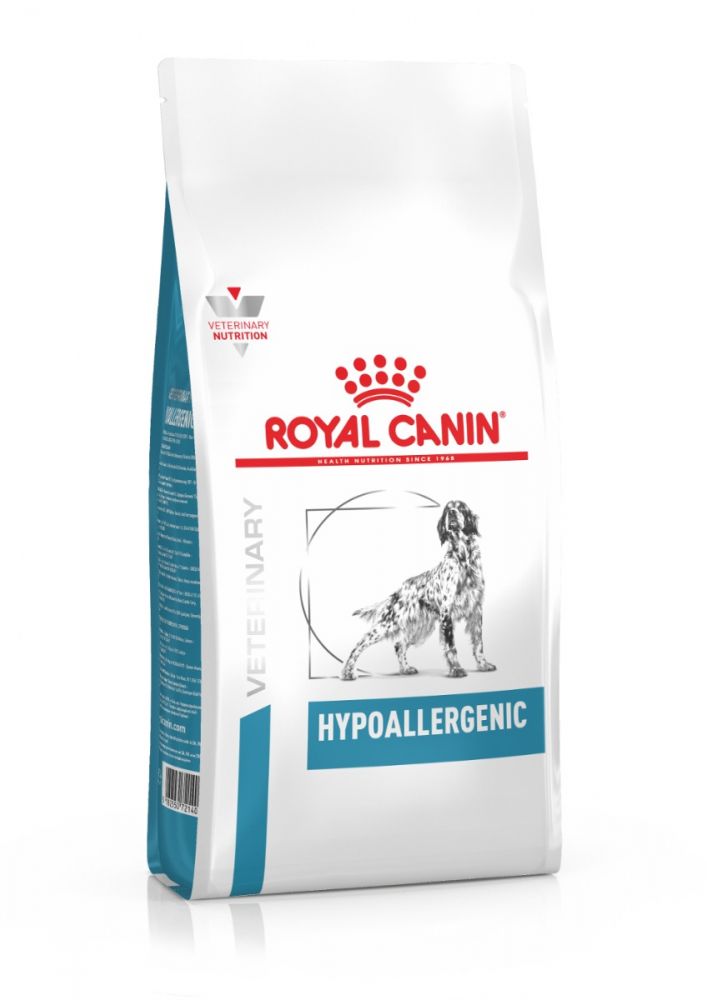Canine hypoallergenic dog food is specially formulated to reduce allergic reactions in dogs. It typically contains limited ingredients and avoids common allergens.
Dogs can suffer from food allergies just like humans. Symptoms may include itching, digestive issues, or skin irritations. Choosing the right dog food can greatly improve your pet's health and comfort. Hypoallergenic options often feature novel proteins and carbohydrates, minimizing the risk of allergic responses.
Many brands focus on using high-quality ingredients to support your dog’s overall well-being. Selecting a hypoallergenic diet can lead to a happier, healthier life for your canine companion. Always consult a veterinarian before making changes to your dog's diet, especially if you suspect allergies. Your dog's unique needs should guide your choices in dog food.
Table of Contents
ToggleIntroduction To Hypoallergenic Dog Food
Hypoallergenic dog food is designed for dogs with food sensitivities. These foods use special ingredients to reduce allergic reactions. Many pet owners choose this option for their furry friends. It can improve health and happiness.
Why Choose Hypoallergenic Options
Choosing hypoallergenic dog food can offer several benefits:
- Reduces Allergies: Helps minimize allergic reactions.
- Improves Skin Health: Supports a healthy coat and skin.
- Enhances Digestion: Easier on sensitive stomachs.
- Boosts Energy: Provides better nutrition for active dogs.
Many dog owners notice a positive change in their pets. This food can lead to fewer visits to the vet.
Common Misconceptions
Several myths surround hypoallergenic dog food:
- All Hypoallergenic Food is Grain-Free: Not all hypoallergenic options lack grains.
- Hypoallergenic Means No Allergens: It does not guarantee zero allergens.
- Only for Allergic Dogs: Healthy dogs can benefit from it too.
- Expensive Equals Better: Price doesn't always mean quality.
Understanding these misconceptions helps in making informed choices. Always consult with a vet before switching foods.
Identifying Allergies In Dogs
Identifying allergies in dogs is crucial for their health. Allergies can cause discomfort and lead to serious issues. Understanding the signs helps you act quickly.
Signs And Symptoms
Watch for these common signs of allergies:
- Itching: Excessive scratching or biting.
- Red skin: Inflammation or rashes.
- Ear infections: Frequent shaking or scratching ears.
- Watery eyes: Discharge or redness around eyes.
- Digestive issues: Vomiting or diarrhea.
Symptoms can vary. Some dogs might have mild reactions. Others may experience severe discomfort.
Diagnosis Process
Diagnosing allergies in dogs involves several steps:
- Veterinary visit: Schedule an appointment with your vet.
- Medical history: Provide details about your dog's health.
- Allergy testing: Your vet may recommend skin or blood tests.
- Elimination diet: Change food to identify food allergies.
Tests help pinpoint specific allergens. Early diagnosis leads to better treatment options.
| Test Type | Description | Purpose |
|---|---|---|
| Skin Test | Small amount of allergens injected | Identify environmental allergies |
| Blood Test | Blood sample tested for antibodies | Detect food and environmental allergies |
| Elimination Diet | Feeding specific ingredients | Identify food allergies |
Common Allergens In Dog Food
Many dogs suffer from food allergies. Understanding these allergens helps owners choose the right food. Some ingredients trigger allergic reactions in dogs. Identifying these can improve your dog's health.
Proteins Triggers
Proteins are common allergens in dog food. Many dogs react to specific animal proteins.
- Beef: A frequent cause of allergies.
- Chicken: Another common protein trigger.
- Fish: Some dogs may have sensitivities.
- Lamb: Often used in hypoallergenic diets.
Switching to novel proteins may help. Options include:
- Rabbit
- Duck
- Venison
Grain And Gluten Sensitivities
Grains can also cause allergic reactions. Many dogs struggle with gluten. Common grains include:
| Grain | Potential Issues |
|---|---|
| Wheat | Can lead to digestive problems. |
| Barley | May cause skin irritations. |
| Rice | Less common, but can still affect some dogs. |
Opting for grain-free dog food can help. Many brands offer high-quality grain-free options.
Benefits Of Hypoallergenic Diets
Hypoallergenic dog food offers many benefits for your furry friend. These diets help reduce allergies and improve overall health. Dogs often experience fewer digestive issues and enjoy healthier skin and coats.
Improved Digestion
Many dogs suffer from food sensitivities. Hypoallergenic diets can ease this problem. They contain fewer ingredients and are easier to digest.
- Limited ingredients reduce the chance of allergic reactions.
- High-quality proteins are gentle on the stomach.
- Special formulations promote better nutrient absorption.
As a result, dogs experience:
- Less gas
- Reduced bloating
- Fewer stomach upsets
Enhanced Skin And Coat Health
Dogs with allergies often have skin issues. Hypoallergenic diets can improve skin and coat health significantly. They contain ingredients that nourish and protect.
| Ingredient | Benefit |
|---|---|
| Omega fatty acids | Promote shiny coat and reduce itching |
| Antioxidants | Support skin healing and health |
| High-quality proteins | Strengthen skin barrier and reduce irritation |
With these benefits, dogs feel more comfortable in their skin. Healthier skin leads to a happier, more active pup.
Types Of Hypoallergenic Dog Food
Choosing the right type of hypoallergenic dog food is crucial. Dogs with allergies need special diets. Here are two main types to consider:
Limited Ingredient Diets
Limited Ingredient Diets (LIDs) contain fewer ingredients. They help reduce allergic reactions. These diets focus on:
- Single protein source
- Single carbohydrate source
This simplicity helps dogs digest food better. It also allows pet owners to identify allergens easily.
| Pros | Cons |
|---|---|
| Reduces allergy symptoms | May not provide complete nutrition |
| Easy to monitor food reactions | Limited flavor options |
Novel Protein Sources
Novel protein sources are unique proteins. They are not common in regular dog food. This includes:
- Duck
- Rabbit
- Quail
These proteins help avoid allergic reactions. They give dogs new flavors to enjoy.
- Choose a novel protein.
- Check for any reactions.
- Consult with a vet for best options.
Novel protein sources can be beneficial for sensitive dogs. They offer variety and help in managing allergies.

Royal Canin
Transitioning To Hypoallergenic Food
Changing your dog's diet can be a big step. Hypoallergenic dog food helps dogs with food allergies. A smooth transition is important for your dog's health. Follow these steps to make the switch easier.
Gradual Switching Process
Start the transition slowly. A sudden change can upset your dog's stomach. Follow these steps:
- Mix a small amount of hypoallergenic food with the current food.
- Gradually increase the hypoallergenic food over 7 to 10 days.
- Monitor your dog during this time.
- Adjust the ratio based on your dog's tolerance.
This method helps your dog adjust without discomfort. It also allows you to observe any changes in their health.
Monitoring Your Dog's Reaction
Watch your dog closely during the transition. Look for signs of improvement or issues. Key things to monitor include:
- Skin reactions: Look for itching or redness.
- Stomach issues: Watch for diarrhea or vomiting.
- Energy levels: Note any changes in activity.
Keep a diary of your observations. This helps track your dog's progress. Share this information with your vet. They can provide guidance if needed.
Home-cooked Vs. Commercial Options
Choosing between home-cooked and commercial options for canine hypoallergenic dog food is essential. Each choice has unique benefits and drawbacks. Understanding these helps in making an informed decision for your dog's health.
Pros And Cons Of Homemade Diets
Home-cooked meals can be tailored to your dog’s needs. They allow control over ingredients. However, they come with challenges.
| Pros | Cons |
|---|---|
| Customizable ingredients | Time-consuming to prepare |
| Fresher meals | Need to balance nutrients |
| Control over allergens | Potential for contamination |
| Can improve picky eaters' appetites | More expensive than commercial options |
Homemade Dog Food
Selecting The Right Commercial Brand
Choosing the right commercial hypoallergenic dog food is vital. Look for reputable brands that focus on quality. Here are some tips:
- Check for AAFCO certification.
- Read ingredient labels carefully.
- Look for limited ingredient diets.
- Seek brands with positive reviews.
- Consult your veterinarian for recommendations.
Understanding your dog's specific allergies is crucial. Conduct a thorough search before making a purchase. Your dog’s health and happiness depend on it.

Royal Canin
Reading And Understanding Labels
Understanding dog food labels is crucial for your pet's health. It helps you choose the right canine hypoallergenic dog food. Clear labeling allows you to spot allergens and select safe ingredients.
Deciphering Ingredients Lists
Reading ingredients lists can be tricky. Here are some tips to simplify the process:
- First Ingredient: Look for a high-quality protein source.
- Whole Ingredients: Choose foods with whole ingredients. Avoid fillers.
- Named Proteins: Select foods with named meats like chicken or lamb.
- Grain-Free Options: Consider grain-free options if grains cause issues.
Here’s a quick guide to ingredient types:
| Ingredient Type | Examples | Why It's Good |
|---|---|---|
| Proteins | Chicken, Beef, Fish | Builds muscle and supports health |
| Fruits & Vegetables | Carrots, Blueberries | Provides vitamins and minerals |
| Healthy Fats | Fish oil, Flaxseed | Supports skin and coat health |
Identifying Hidden Allergens
Some allergens hide in common ingredients. Watch out for:
- By-Products: These can contain allergens.
- Artificial Additives: Colorings and preservatives may trigger allergies.
- Grains: Wheat, corn, and soy often cause reactions.
- New Ingredients: Avoid unfamiliar ingredients in new foods.
Check for these common allergens:
- Wheat
- Beef
- Chicken
- Dairy
Understanding these labels helps keep your dog safe and healthy.
Supplementing Your Dog's Hypoallergenic Diet
Feeding your dog a hypoallergenic diet is essential for managing allergies. However, some dogs may need additional nutrients. Supplements can help fill these gaps.
Essential Nutrients And Vitamins
A balanced diet is vital for your dog's health. Here are some key nutrients:
- Omega-3 Fatty Acids: Promote healthy skin and coat.
- Antioxidants: Support the immune system.
- Vitamins A, D, E, and K: Important for overall health.
- B Vitamins: Aid in energy metabolism.
Consider these supplements:
| Supplement | Benefit |
|---|---|
| Fish Oil | Reduces inflammation and supports skin health. |
| Probiotics | Improves gut health and digestion. |
| Glucosamine | Supports joint health and mobility. |
When To Use Supplements
Not all dogs need supplements. Consider these situations:
- When your dog shows signs of nutrient deficiency.
- If your dog has specific health issues.
- During periods of stress or recovery.
- If your dog’s hypoallergenic food lacks certain nutrients.
Take advice from Pet Expert Dr Marty
ESA Pet is an online service that helps you get a legitimate ESA letter
Pet vitamin supplements and grooming products
Always consult your veterinarian before adding supplements. They can recommend the best options for your dog.

Royal Canin
Dealing With Picky Eaters
Many dogs can be picky about their food. This makes feeding them a challenge. Canine hypoallergenic dog food is essential for dogs with allergies. Finding a food they enjoy is just as important. Below are some strategies to help you.
Encouraging Transition
Changing your dog's food requires patience. Here are some steps to make the process easier:
- Gradual Mixing: Start by mixing old food with new food.
- Small Portions: Serve smaller portions of the new food.
- Consistency: Feed at the same time every day.
- Positive Reinforcement: Reward your dog for eating.
Transitioning may take time. Monitor your dog's reaction to the new food. If they refuse to eat, try adjusting the mix.
Tips For Stubborn Dogs
Some dogs are more stubborn than others. Here are tips to help:
- Add Flavor: Mix in low-sodium broth or dog-safe toppings.
- Warm the Food: Slightly warm the food to enhance the aroma.
- Use Puzzle Feeders: Make mealtime fun and engaging.
- Limit Treats: Reduce treats to encourage eating the main meal.
Be patient with stubborn eaters. Consistency and creativity can make a difference. A happy dog is worth the effort.
Common Challenges And Solutions
Choosing canine hypoallergenic dog food can be tricky. Many pet owners face challenges. Understanding these challenges helps in finding effective solutions.
Cost Management
Hypoallergenic dog food can be expensive. Prices vary widely based on brand and ingredients. Here are some tips for managing costs:
- Buy in bulk to save money.
- Look for sales or discounts.
- Consider making homemade hypoallergenic food.
Table below shows average costs:
| Brand | Average Cost (per bag) |
|---|---|
| Royal Canin | $50 |
| Purina Pro Plan | $40 |
| Hill's Science Diet | $60 |
Maintaining Variety In Diet
Feeding your dog the same food can lead to boredom. Dogs need variety for nutritional balance and enjoyment. Here are ways to keep their diet interesting:
- Rotate brands every few months.
- Mix dry food with wet food.
- Introduce new protein sources like lamb or fish.
- Use safe vegetables as treats.
These steps help keep your dog's meals exciting. A varied diet supports overall health.
Success Stories And Owner Testimonials
Many dog owners share their journeys with canine hypoallergenic dog food. These stories highlight the positive changes in their pets' lives. Owners report improvements in health, behavior, and overall happiness. Here are some inspiring testimonials from real pet parents.
Real-life Improvements
Many pet owners noticed significant changes after switching to hypoallergenic dog food. Here are a few success stories:
- Max the Golden Retriever: After switching foods, his skin allergies cleared up. His energy levels soared, and he became more playful.
- Luna the Beagle: She used to have digestive issues. The new food improved her digestion and reduced her stomach upsets.
- Buddy the Poodle: His itchy skin and excessive scratching stopped. Now, he enjoys a shiny coat and healthy skin.
These stories showcase how hypoallergenic dog food can transform a pet's life.
Owner Advice And Tips
Here are some tips from dog owners who made the switch:
- Consult Your Vet: Always talk to your vet before changing your dog's food.
- Gradual Transition: Mix old food with new food over 7-10 days.
- Observe Changes: Keep a close eye on your dog's behavior and health.
- Stick to a Schedule: Feed your dog at the same time every day.
- Choose Quality Brands: Research and select trusted hypoallergenic dog food brands.
These tips can help other pet owners find success with hypoallergenic dog food.
Final Thoughts On Choosing Hypoallergenic Food
Choosing the right hypoallergenic dog food is crucial for your pet's health. Understanding your dog's needs helps prevent allergies and promotes overall well-being.
Recap Of Key Points
Here are the main points to remember:
- Identify Allergens: Work with your vet to pinpoint allergens.
- High-Quality Ingredients: Choose foods with premium, limited ingredients.
- Protein Sources: Consider novel protein sources for less allergenic reactions.
- Gradual Transition: Slowly introduce new food to avoid upset stomachs.
- Monitor Reactions: Keep track of any changes in your dog's health.
Encouragement For Ongoing Health
Maintaining your dog's health is an ongoing journey. Regular vet visits ensure your dog stays healthy.
Provide a balanced diet rich in essential nutrients.
Consider these tips:
- Stay consistent with feeding times.
- Keep fresh water available at all times.
- Engage in regular exercise for physical health.
- Pay attention to your dog's behavior and energy levels.
Invest time in your dog's nutrition. A healthy diet leads to a happy life.
Frequently Asked Questions About Canine Hypoallergenic Dog Food
What Is Canine Hypoallergenic Dog Food?
Canine hypoallergenic dog food is formulated to minimize allergic reactions in dogs. It usually contains limited ingredients and avoids common allergens like wheat, corn, and certain proteins. This type of food helps dogs with food sensitivities digest better and maintain overall health.
Who Should Use Hypoallergenic Dog Food?
Hypoallergenic dog food is ideal for dogs showing signs of allergies. Symptoms include itching, gastrointestinal upset, or skin irritations. Consult your veterinarian if you suspect food allergies. They can recommend the right hypoallergenic diet based on your dog’s specific needs and health conditions.
How Does Hypoallergenic Dog Food Work?
Hypoallergenic dog food works by using novel proteins and carbohydrates. These ingredients are less likely to trigger allergic reactions. The limited ingredient approach simplifies digestion and helps identify specific allergens. This can lead to improved health and comfort for your dog.
Can All Dogs Eat Hypoallergenic Dog Food?
Not all dogs need hypoallergenic dog food. It is specifically designed for those with food allergies or sensitivities. If your dog shows no signs of allergies, a regular diet may suffice. Always consult your veterinarian before making dietary changes to ensure it’s appropriate for your pet.
Shop Form Devoted Pet Foods UK
Conclusion
Choosing the right hypoallergenic dog food can significantly improve your pet's health. It helps manage allergies and promotes better digestion. Always consult with your veterinarian before making changes to your dog's diet. By selecting high-quality ingredients, you ensure a happier, healthier life for your furry friend.
Prioritize their well-being today.














